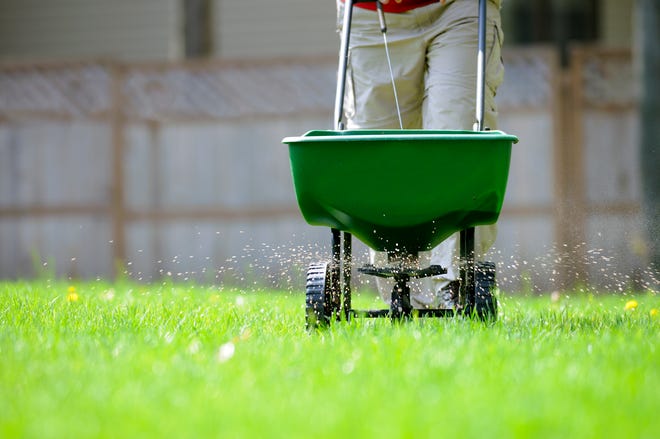Gardening: The fertilizer deadline nears

June is fast approaching and if you have not yet completed your spring fertilizing you need to get it done.
When purchasing fertilizer, it is important to understand the fertilizer label on the bag. A 16-2-8 analysis on a 100 pound bag means it contains 16 lbs. of nitrogen, 4 lbs. of available phosphoric acid, and 8 lbs. of soluble potash. The first number is always nitrogen, the second phosphorus, and the third, potassium. In addition to these three primary nutrients any secondary nutrients, or micro-nutrients, are reported at the bottom of the label. Micro nutrient needs can differ for plants thus labels for palm, citrus, etcetera.
More:Gardening: Play it cool with the rising heat
For lawns a 16-0-8 or a 15-0-15 would both be good choices. Turf needs more nitrogen than woody plants for turf density. This allows it to fight off weeds, tolerate foot traffic, and resist attacks from insects and diseases. However, too much nitrogen can also cause problems, notably disease. When the plant takes up too much nitrogen, its cell walls become thin making it easier for fungi to invade. This will in turn cause a higher than normal need for water. Also, this lush growth attracts insects.
Turf will have a higher quality using a slowly soluble or a controlled release material. Look for the following when purchasing your lawn fertilizer.
- Sulfur coated urea: Nitrogen release occurs as water moves through tiny cracks and pinholes in the sulfur coating. Another benefit of sulfur is that it helps with a high soil ph. A constant battle with our high alkaline, shell and sand soil.
- Polymer coated urea: Urea granules with a polymer coating. Water diffuses through the coating to dissolve urea. Nitrogen release with a polymer coating is affected by temperature and is more rapid in summer and slower in cold winter.
- Sulfur and polymer coated urea: Polymer coating is added to the sulfur coated urea as protection and to slow the movement of water into the core. It combines the cost advantage of sulfur coated urea and improved release of polymer coated urea.
While these fertilizers are expensive, your lawn will be healthier if you use them and thus cheaper to maintain throughout the year in terms of water, insecticides and fungicides. You also help the environment.
Palms under three feet use 6-6-6 monthly for maximum growth. For palms over three feet, four times a year in early spring, late spring, summer and early fall using a palm fertilizer at the rate of 1 lb. per foot of trunk. Be sure to use the micro-nutrients, especially manganese and magnesium, on your palms.
More:On the Hook: Breaking point
For shrubs, vines and hedges a good quality 6-2-6 or 8-2-8 analysis is recommended at a rate of one and a half pound per 100 sq. ft. Palm fertilizer is an excellent choice for all your acid-loving plants. Four applications, in early spring, late spring, summer and early fall is optimal but I have found that if your plants and trees are healthy, two fertilizations using a quality slow release nitrogen with micro-nutrients, in early spring and early fall keeps the plants healthy and growing vigorously. Always keep in mind that limited fertilization is much better for the environment than excessive fertilization.
Bougainvillea prefers only once a year fertilization with 6-6-6 or 8-8-8 at a rate of 1/4 lb. per foot of height of bushy plant. While the middle number, phosphorous, is being regulated for polluting our environment this element can aid in flowering as well as root growth.
More:Fishingcast: Conditions for May 8-14
Citrus should be fertilized at a rate of one and a half pound of 6-6-6 every six weeks for the first three years. After first planting your citrus tree, wait until new growth begins before fertilizing. After three years apply one pound for each year of age of the tree with each application of citrus fertilizer in January, June and October. Reduce to one and a half pound of fertilizer for each year of age after ten years old. Normally, if you missed the January fertilization you should wait until your fruit has set to fertilize. Many citrus trees on the island are just blossoming now so watch for the fruit to set before you fertilize your trees. If your citrus are in bloom fertilizing may cause the blooms to drop resulting in a reduced crop.
More:Gardening: The flowering trees of Florida
Remember use only what you need to keep the plants healthy. Over fertilizing will attract bugs, disease and a need for more water. All things bad for the environment.
Eileen and Peter Ward have owned a landscape and lawn maintenance company for 35 years. Eileen can be reached at Gswdmarco@comcast.net or 239-394-1413.